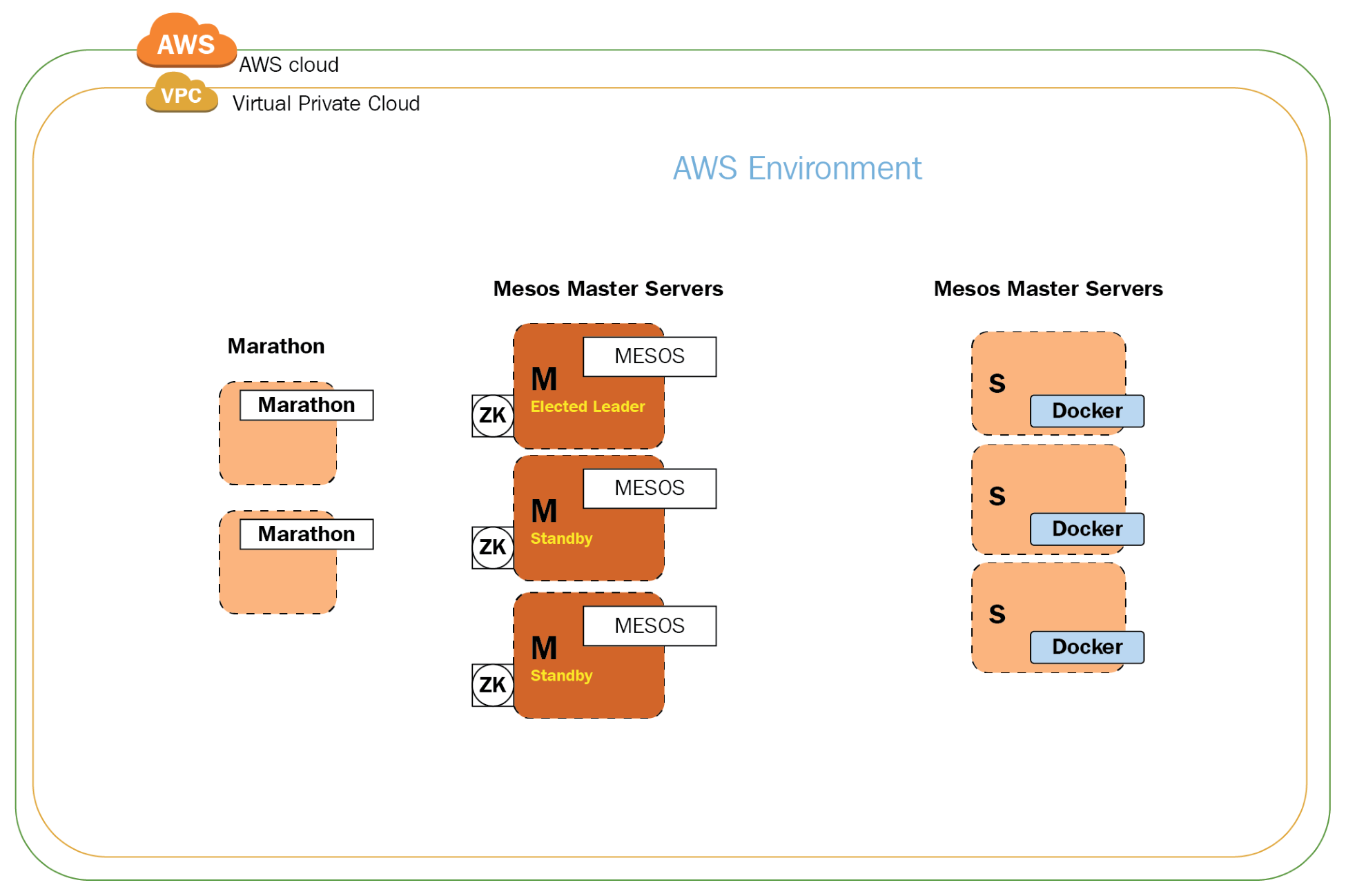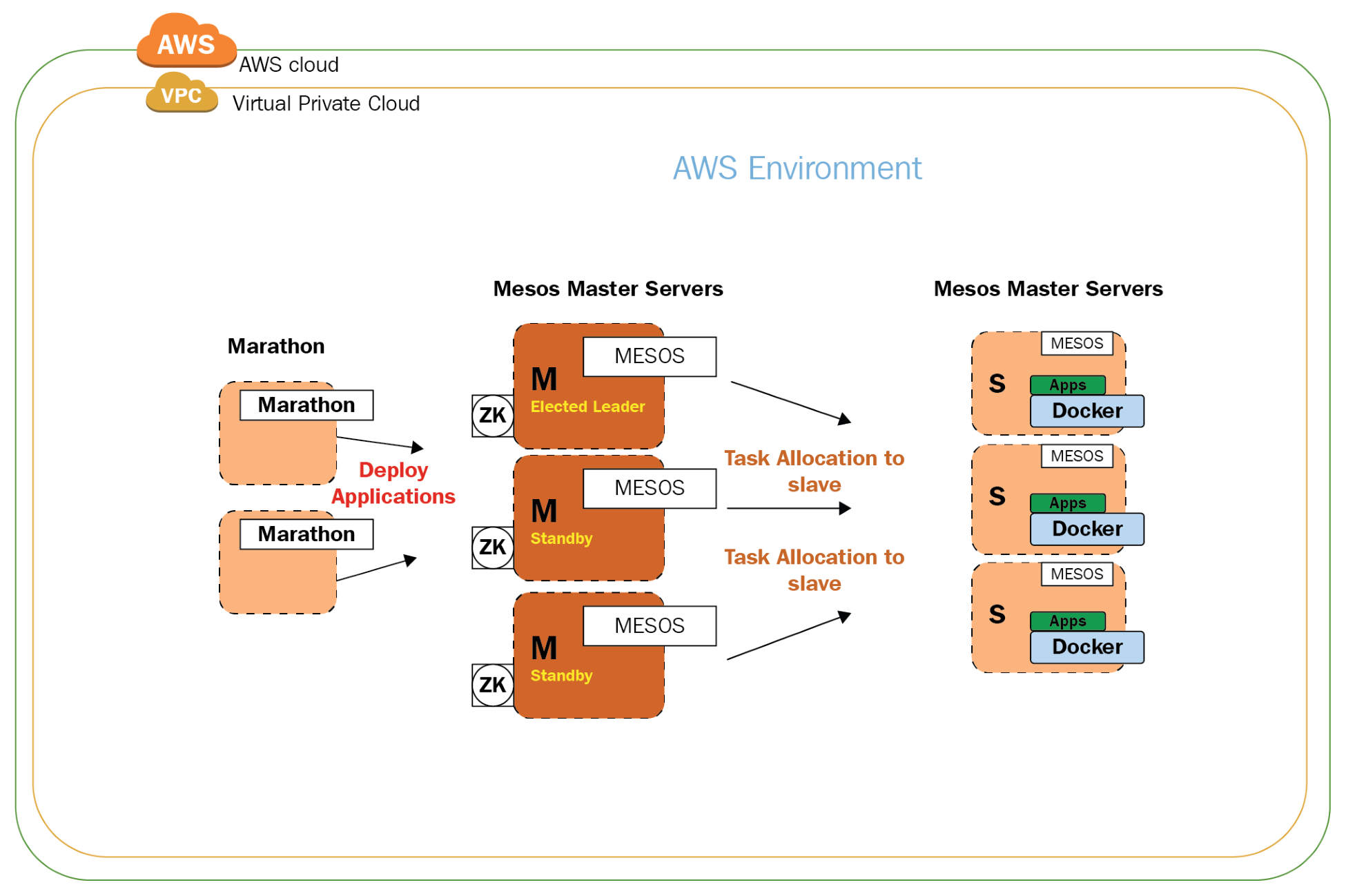Deploying Apache Mesos on AWS
In the IT world today, some of the types of applications being developed cannot survive on a single computer. This is because these applications are accessed by a large number of users. Also, different types of applications means different platforms, such as Java and .NET.
Apache Mesos is a concentrated fault-tolerant cluster-management tool that is used for distributed computing environments that provides resource-isolation and management across a cluster of slave nodes. It efficiently manages the CPU memory and disk resources across the cluster, schedules the resources according to requirements, and deploys the apps. It is a highly available master through Apache ZooKeeper.
Apart from this, Apache Mesos also provides features such as application scheduling, scaling, faulttolerance, and cellfilling. It also supplies an application service discovery tool.
In this chapter, we will cover the following topics:
- Installation and configuration of a highly available cluster in Apache Mesos
- Setting the failure configuration in case the master nodes go down
- Setting up a Mesos slave server to handle the Docker-related tasks, which are scheduled by Marathon
Introduction to Apache Mesos
Imagine an e-commerce application server where, if you are selling a product, lots of users access your website. This creates a huge amount of data and requires more CPU memory and disk space. Day-by-day users increase, so the demand for resources increases. To cater to these needs, you use data centers and the cloud to provide these additional resources. Apache Mesos helps to manage and share these resources in an efficient manner, and also helps us with scalable deployments by forming a cluster.
A Mesos cluster is made up of four major components:
- ZooKeeper
- Mesos masters
- Mesos slaves
- Frameworks
Architecture of Mesos
Mesos has an architecture with the combination of master and slave daemons and frameworks. Here are a few definitions of components used in our architecture:
- Master daemon: Mesos master runs on a master node and organizes the slave daemons, so we will have three master nodes where we will install Mesos master, and it will manage the Mesos slave server, which runs on the other three servers.
- Slave daemon: Mesos slave runs on slave nodes and runs tasks that belong to the framework, so we will be having a Marathon framework, which will register with the Mesos master and will schedule the Docker containers, and those Docker containers will run on Mesos slave servers.
- Framework: The framework, which can also be called the Mesos application, consists of a scheduler, which registers with the master to achieve resource offers, and one or more executors, which pushes the tasks on slaves. An example of a Mesos framework is Marathon. The Marathon framework can be used in the scheduling of tasks. So, the Marathon framework gets registered with the Mesos master and it receives the resource offers. This framework also deploys the application on the Mesos cluster, which gets launched on slaves.
Following are other important components of the Mesos architecture:
- Offer: The master gets offers from the slave nodes and the master provides offers to the registered frameworks. So, all the resources are on slave node, such as CPU memory and disk, and then the Mesos master provides offers to the registered framework, which is Marathon.
- Task: A unit of work that is scheduled by a framework, Marathon, and tasks are like Docker. If we run any image of Docker, those Docker images will run on a slave node. Tasks can be anything, from a bash command, or script, or running a Docker container.
- Apache ZooKeeper: It's a software that is used to coordinate the master nodes. It elects the master leader, and if out of three nodes any node is down, it again elects the leader from the remaining two nodes. A minimum of three nodes is required to form a cluster.
Introduction to Amazon Web Service (AWS)
AWS is a secured cloud service platform that offers computing power. This is where we can run an EC2 instance for our master and slave, and then for the Marathon framework. It offers database storage as well.
We will use a MySQL database that offers more functionality to help the environment scale and grow.
AWS environment
For creating a VPC, EC2 instance, security groups, and load-balancers, perform the following steps:
- Create a Virtual Private Cloud:

- Create an EC2 instance: two for Marathon, three for Mesos master servers, and three for the Mesos slave servers:

- Install the Mesos master application, Marathon:

- Install ZooKeeper:

- Insert Docker to run Docker images on all the slave servers. We will install the Mesos slave as well:

- Use Marathon to deploy the application, and those tasks will launch on slave servers. We will use a WordPress Docker container:

Also, we will see how to load-balance Marathon and Mesos master servers. This will help to manage the Mesos UI and Marathon UI. It is not necessary to go every time on each Marathon server as the load-balancer will take care of that. If one of the master servers is down, it will redirect to another one, so this is where your management will become easy:

Use Marathon-lb HAProxy to load-balance your application request:

This was a quick overview of what we are going to cover in the upcoming chapters.
Summary
In this chapter, we explored the components of Apache Mesos. We also went through the overall architecture of Mesos. Then we covered the procedure of setting up an AWS environment.
In the next chapter, we will learn how to set up a Mesos single-cluster node. We will discuss some of the considerations in setting up a development environment. We will also use minimum server to deploy Mesos components for development purposes to build a development environment for Mesos using a Mesos single-cluster node setup.




















 Download code from GitHub
Download code from GitHub
